Sunday, 7 March 1999
Laguna Colorada, Potosí, Bolivia
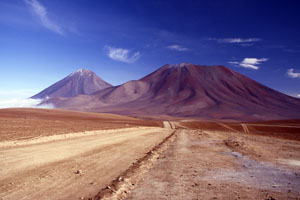
(Laguna Colorada, Potosí, Bolivia)
Going from San Pedro de Atacama, Chile to Uyuni, Bolivia you get your departure stamp the morning you leave San Pedro and your entry stamp on arrival in Uyuni. Thus you spend three days in a state of limbo. We were loaded up in minibuses and taken to Laguna Blanca, the first of the flamingo lakes. During the trip we climbed up through a red rocky desert which really looked the part. At Laguna Blanca we had some breakfast and transferred to the four wheel drive jeeps that were to be our home for the next few days. Before we departed we were able to have a look around. Laguna Blanca was a pretty desolate place, a white lake which played host to a couple of flamingoes, it nestled in the shadow of six thousand metre chocolate brown perfect cone of Volcan Licancabur.
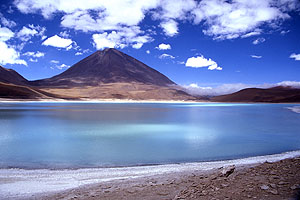
(Altiplano, Potosí, Bolivia)
Next stop was Laguna Verde. The problem with this lake is that it only lives up to its name when the sun is shining and the wind blows in the right direction. Since neither of these things was happening that day it just looked like a pretty standard lake. Well as standard as anything can look in the desolate conditions of the Altiplano. Further on up the road we had a bit of a treat. At Chalviri several hot springs cascaded down by the side of the road flowing into beautifully warm pools. Only a percentage of our convoy had been prepared for this and so I was only joined in the waters by a select few. After we had dried off we had lunch.
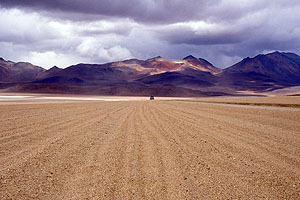
(Laguna Colorada, Potosí, Bolivia)
Our fellow passengers deserve a mention. We were split between three jeeps. In our jeep was: Rebecca, an Australian botanist working for their Federal parks department at Jarvis bay; Hans, a Dutch civil engineer and his girlfriend Ester, an architect who originated from Barcelona; and three Australian girls on a world tour with their sights set on working in London. We spent most of the first day talking to Rebecca, Hans and Ester.
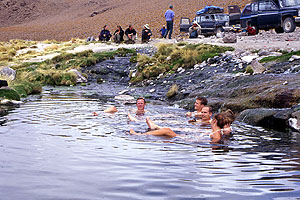
(Altiplano, Potosí, Bolivia)
After the hot springs we headed for the Sol de Manana geyser basin. I am not sure if it was more spectacular than El Tatio, certainly the sun was out which made it a lot more photogenic. It consisted of a pitted landscape of vents and plopping mud pools. The vents nearest to where the vehicles were parked were the most spectacular, over two metres in diameter they spewed great clouds of steam and made a noise not too different from a jet engine. We walked around the basin but very slowly as we were once again at a very high altitude.
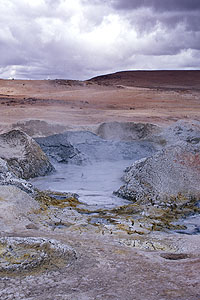
(Altiplano, Potosí, Bolivia)
Laguna Colorada was the last stop of the day. As we approached we realised that it was something special, it was covered in flamingoes but was also pink. The colour was very unnatural and due to the algae that the flamingoes eat. Sadly we did not get the driver to stop for a picture at first and by the time we reached Campamento Ende it had started raining and there was no chance of a picture. In fact it did not really stop raining until the early hours of the next morning. We went into the "hotel" and were assigned to a dormitory and then sat around chatting. After a while of chatting we began to realise that the "hotel" was not as waterproof as it could be. Water dripped onto the floor, onto beds etc. The guides went out to fix the roof and we carried on chatting and drinking mate de coco. An okay dinner was prepared by our cook, a Bolivian woman who insisted on wearing sunglasses all the time perhaps in attempt to look even more like Yoko Ono than she already did.
Monday, 8 March 1999
San Juan, Potosí, Bolivia
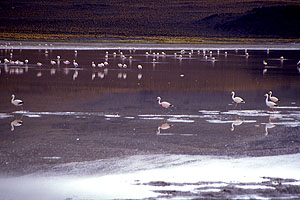
(Laguna Colorada, Potosí, Bolivia)
It turned out that the only person who slept more than a couple of hours that night was Anna. The problem was three-fold, firstly we were sleeping at an altitude of nearly 4300m and we ad not yet acclimatised. As a result I had an all night long headache which was not unlike a hangover. Secondly the beds were very uncomfortable, they had collapsed to the point that they were almost U-shaped and the pillows were about ten centimetres square. Finally every time anyone turned the beds squeaked so badly that even if you had got some of the way to sleep you were son awake again. Someone said the next morning that they were so conscious of the fact that their bed squeaked that they would wait until someone else turned before turning themselves. It was a bad night and very few people were in a good mood the next morning.
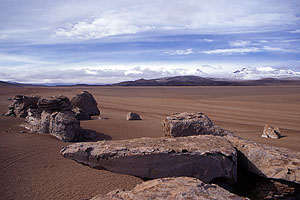
(Altiplano, Potosí, Bolivia)
Although it had stopped raining it was still overcast. After breakfast we walked part way around the lake in an attempt to get a close-up of a flamingo - which was not easy as they are very easily scared. Eventually we set off leaving Laguna Colorada behind us. The all night rain had left all the chocolate brown mountains of the Altiplano with a white sprinkling of snow. We cut up through a pass and then started to head downwards. The first stop of the day was at a place where outcrops of rocks in a desert valley had been weathered into unusual shapes. Being old hands at the unusual shaped rocks game we just shuffled around a bit and did not get that excited. I persuaded Ester and Hans that an overhanging rock would be a great place for a "hanging above the Altiplano shot" and even offered to act as a counterweight while Ester stood on the edge. Amusingly Hans turned out to be even more fussy about framing than me and after about ten minutes I was forced to abandon my counterbalancing role. I went off to find Anna and after sitting on a rock with her for a while we went off to look at the "rabbit" that someone had spotted. It turned out to be a Viscacha, a long-tailed relation which has a yellow grey coat which can hardly be distinguished from the surrounding rocks.
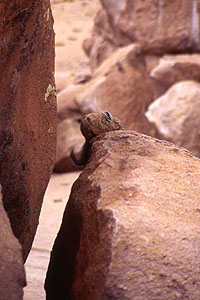
(Altiplano, Potosí, Bolivia)
Back in the car everyone either drifted back to sleep or a sleep deprivation induced silence. After more stunning scenery we eventually stopped for lunch in a very shallow gully between some formations of red rock. It was quite an interesting place, many of the rocks were eroded into "melted cheese" formations, there were llaretas all over the place and we even found a couple more viscachas. Anna and I wandered around a lot trying to find something that would make these already weird place seem weirder but to no avail.
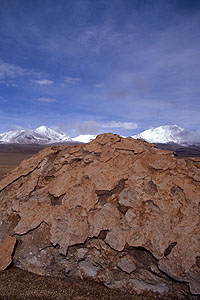
(Altiplano, Potosí, Bolivia)
So far the road had been pretty nonexistent and a little rough but not enough for our careful driver to engage the four wheel drive. However we soon encountered an obstacle in the form of the Salar de Chiguana. A salar is basically the remains of a lake after it has dried up. In the case of the Salar de Uyuni it is a massive white expanse of salt, in the case of the Salar de Chiguana it is a massive expanse of mud not made any easier to cross by the fact that it had been raining all of the night before. We slipped all over the place and mud sprayed everywhere but we eventually got there. The jeep following us, whose four wheel drive would not engage had a more adventurous time of it and we somewhat ungallantly cheered every time it fish tailed (once it nearly even did a 180 degree spin!). After a Bolivian military checkpoint (we still did not have our entry stamps) and more mud we eventually reached San Juan.
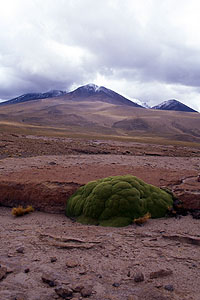
(Altiplano, Potosí, Bolivia)
In comparison to the picture perfect pueblo of San Pedro, San Juan could have been accused of being a bit scruffy. Its site, in the midst of a sparsely vegetated mountain ringed valley at an altitude of thousands of metres reminded us very much of Tashkurgan, the endpoint for our similarly epic crossing of the Pakistani-Chinese border months before. In their walled gardens the residents grew flowers and baked bread in huge ovens. There seemed to be no visible form of income other than us but something must have paid for the new basketball courts that we found. We wandered around the village after dumping our bags at one of the many hostels. We found little apart from an ancient cemetery - nevertheless we came to like the atmosphere of what was a very sleepy town.
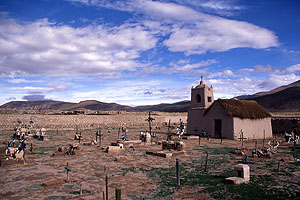
(San Juan, Potosí, Bolivia)
After a long walk we returned and finding Hans and Ester there we kept each other amused until dinner. After dinner the four of us decided to brave San Juan's nightlife. Sadly the very pleasant "pub" had run out of beer so we were forced to go to the "disco". This was little more than a few tables, a blue fluorescent tube and a couple of very distorted tapes. However they at least had some bottles of "Huari" - the local brew - and we stayed there until the very late hour of eleven.
Tuesday, 9 March 1999
Uyuni, Potosí, Bolivia
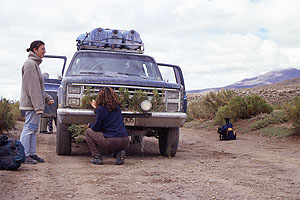
(Salar de Uyuni, Potosí, Bolivia)
The hostel at San Juan did not have much but at least it had hard beds. We slept the sleep of the dead and felt a lot better for it that morning. It took a lot of messing around but eventually we and the jeeps rolled out of town. Not much happened that morning the only stop was made to waterproof the jeeps with heather picked from the side of the road. It was stuffed in every hole, the engine was filled with it and the radiator covered by a hedge of it.
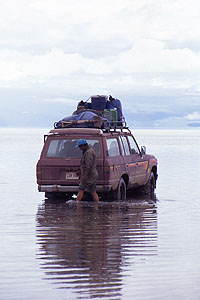
(Salar de Uyuni, Potosí, Bolivia)
The Salar de Uyuni is an amazing place. We realised we were close when we saw several islands floating above the horizon. The rain had provided the salt flats with a few centimetres of water cover and from a distance it looked like a mirror. A raised road stretched out into it but after a few kilometres this ran out and we had to stop. We got out of the jeeps and the drivers prepared them further by tying plastic sheets to their bumpers in an effort to keep the corrosive salt spray away from the engine. As we waited another jeep came racing past and drove out into the water. About ten metres from the raised road it came to a halt, stuck in the water. Our jeep came to the rescue and it was towed out but it made us realise that we were in for a difficult drive.
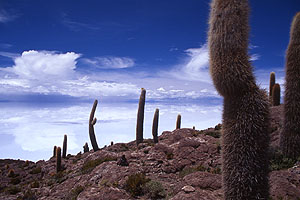
(Salar de Uyuni, Potosí, Bolivia)
Racing over the water covered Salar was an amazing experience. Water sprayed up to either side and apart from the ripples caused by us the surface was mirror still. The clouds were reflected so that they were both above and below us, the only way we could find the horizon was by finding an axis of symmetry. Under the water we began to make out patterns. The white salt had cracks in it forming irregular hexagonal tiles. We sped towards a floating blob on the horizon which we assumed would be the Isla de Pescadores, a cactus covered rock in the middle of the Salar.
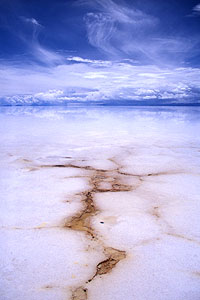
(Salar de Uyuni, Potosí, Bolivia)
When we eventually reached it the Isla turned out to be even more bizarre than the pictures of it in the Lonely Planet. Imagine a salt baked and eroded rock in the middle of a white mirror. Covering the rocks are hundreds of tall branched cacti and picking their way between them a couple of confused alpacas. It really is the sort of place that defies description and unless a 360 degree panorama camera were invented a photo could never express the isolation. In short it was so weird that any pictures that I do get will be more believable as stills from a sci-fi film than pictures of anywhere on earth.
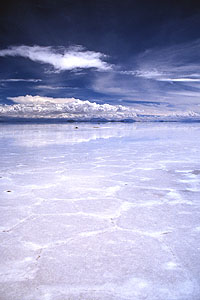
(Salar de Uyuni, Potosí, Bolivia)
Well it did not seem quite so Lovecraftian once there were four jeeps and thirty people crawling on it. I rushed to the top, nearly killing myself but managing to be first and capture at least some sense of desolation before I was joined by everyone else. We all mooched around the top a bit at a loss for words and then circled around back to where the cars were parked for lunch. On the way back Hans and I annoyed Anna and Ester by making a long saga of taking photos of the few cacti that were in flower. We had a really nice lunch and then we wandered out on to the salt to attempt to take a few photos of the salt formations which were barely covered by a film of water.
Driving on it again seemed like we were flying or skating. The sun was shining, a fine arc of spray flew up from the front wheels and pretty soon we could again see nothing but clouds above and below us. Heaven only knows how they were navigating but after an hour we could make out a building on the horizon. It was the Hotel de Sal which I had imagined would be a very basic hotel with a few white rooms - in fact it was a kitsch nightmare of monstrous proportions. You see everything was built out of salt, salt chairs, salt tables, salt bed bases, salt chessboards. At the salt bar they sold salt llamas and salt turtles. The bathroom was locked. Worse than this they were half way through building Hotel de Sal II and we exploring the building site we found a salt Christmas tree, a salt pool table, what looked like it was going to be a salt hot tub etc. It was like someone had taken a fairly novel idea and then gone apeshit with it. We failed to buy anything and got back into the jeeps.
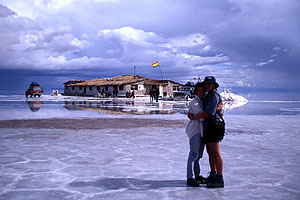
(Salar de Uyuni, Potosí, Bolivia)
It was a shame that the trip had to end but in about another hour we found ourselves pulling into Uyuni, a smallish town on the eastern shores of the Salar which not surprisingly gets its income from salt mining. We were sad to get out of our jeeps especially since they are such a great way of exploring the country as compared to bus. In a very haphazard way the travel agents herded us through the streets towards the small immigration office where are passports were stamped and we were finally out of limbo.
Surprisingly, considering its location, Uyuni is a pretty pleasant place. The first thing you notice is how Bolivian it really is - the women all wear hundreds of skirts, have their hair in two long plaits and perch something not unlike a bowler hat on the top. The hotel we found was basic but very clean. We had dinner in a very nice (but clearly very tourist oriented) pizzeria which even laid on entertainment in the form of two excellent charrango players one of whom sung.
Wednesday, 10 March 1999
Potosí, Bolivia
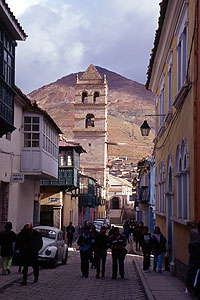
(Potosí, Bolivia)
Despite the fact that Uyuni was a bit more civilised than we had first thought we were still getting out of it as quickly as possible. The bus ride to Potosí was pretty dramatic, taking in some very desolate terrain including some strange green and violet mountains. Potosí was founded in the sixteenth with the sole aim of mining the silver rich Cerro Rico. The amount of silver that the Spanish mined from it was immense and what was left after Francis Drake and various other pirates plundered the shipments went back to Spain to fund various wars. However something like a quarter of the money remained in Potosí and with this money the highest city in the world was built.
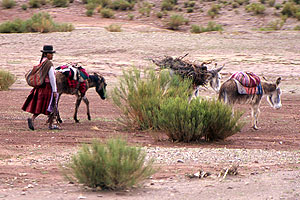
(Potosí, Bolivia)
Apart from the weather we found Potosí very pleasant. It was not easy lugging our rucksacks around at such a high altitude but after a lot of huffing and puffing we found a fairly nice, if not a bit pricey, room. We had a bit of a poke around before finally catching up with Hans and Ester and arranging a trip to the mines for the next day. This process was complicated by the fact that both Anna and Ester were developing rampant claustrophobia by merely looking at photos and were asking questions such as "is it dark?". In the end we managed to negotiate a group discount as well as gaining a little bit of confidence in the guides. We then went off to buy supplies and eat a stupidly large dinner (I had pique a lo macho which is basically a pile of meat covering a few chips) before retiring for the night.
Thursday, 11 March 1999
Potosí, Bolivia
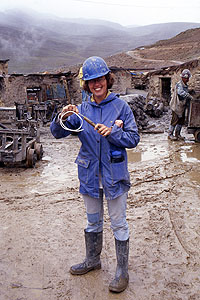
(Potosí, Bolivia)
We all met up outside the agents office at nine. The first shock we had was that our guide did not speak English but, although I was a bit cross, since we had Ester to translate we decided to soldier on. We got on a bus (!) an headed up to the miners' market. The current situation of the mines is a little sad. Basically all the major veins were mined out years ago and the large companies and government pulled out. Now there exists a mishmash of co-operatives and small private companies that mine what is left, tiny traces of silver and previously discarded veins of lead, zinc and copper. The miners have to provide their own equipment - helmets, boots, tools and even dynamite, and at the end of the week sell what they have mined. Tourism exists in an interesting symbiosis with this very primitive system. The tourists are expected to buy presents for the miners and in return the miners put up with the inconvenience of having tourists running around their feet.
We first went to one stall and bought some coca leaves (which the miners chew continuously to keep themselves going) and some cigarettes. We then went up the road to buy them some dynamite. Yes, as strange as it seemed we just went up and bought some sticks of dynamite, fuses and nitrates (for that extra bit of a bang) and walked off with them in a carrier bag just like you were buying a box of chocolates for your mum. We then got a taxi up to the entrance of the mine.
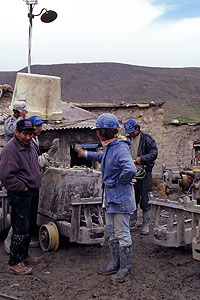
(Potosí, Bolivia)
The equipment provided by the tourist agency was pathetic. If you go down a mine in Europe you have full overalls, a helmet and an electric head lamp. I was equipped with a mac with most of the buttons missing, a helmet with a massive hole in it and a hand held acetylene lamp. On the one hand we were not paying a lot of money, on the other I would not have minded being equipped with something other than miner's cast-offs for a few more dollars. Anyway after a lot of fussing about we were briefed on mine etiquette. The main danger would be, we were told, the ore trucks - one and a half ton buckets of ore pushed along the rails at high speed by the miners themselves. The guide told us that when an "Indiana Jones", as he called it, approached he would shout and we were to back up against the wall. After our lecture we descended into the depths.
It is very hard to explain exactly what it was like in the mine. At some point in the past I visited a museum which had a section devote to mining. It was darkened and as background music they played a looped tape which reconstructed the sounds of mining. You hear the tapping of hammers, the rolling of the ore buckets, the odd explosion and the shouts of the miners. I was reminded of this in the mine not only because it sounded exactly the same but also because you had this feeling that what you were experiencing was not real. It was as if it was some sort of play put on for our benefit or we were seeing echoes of the past.
Anyway our descent into the mine was real enough. We soon found a gallery in which we descended to a lower level of the mine. We travelled along the tunnels and after a while ducked into an alcove. Here we got a bit of a shock because we found ourselves staring into the eyes of the devil. We were saved from heart failure by some prior knowledge. The miners believe that the mines an everything under the ground belongs to the devil and so pay tribute to him. In all of the mines there is an image of the devil and the miners leave alcohol and coca leaves as offerings. Our guide had picked an excellent effigy to start us with, it was ancient and had horns and a beard and black glass eyes that seemed to stare at you. It also had been kitted out with leather knee pads, rubber boots and a penis made of copper sulphate crystals. It was covered in streamers from a celebration and the floor around it was inches deep in coca leaves. The guide sat us down next to it and gave us the low down on devil worship. Despite the statue's crudeness the face and eyes had a very real quality which combined with its obvious age and the dark, close conditions in the mine to make me feel very uneasy.
After the devil we crawled around a bit and found some miners loading ore from the trucks into baskets to be winched into the surface. Every so often orange sparks would fly off into the air as a miners spade struck the ore. We watched them for a while, presented some of our gifts, then moved on. Our next vignette of medieval mining was down a very narrow hole on a very wobbly ladder. Two miners were gouge out a small seam of lead using little more than hammers and spikes. One would chip lumps of rock out of the roof of the tiny hole we were in and the other would break the lumps up and put the shiny bits into a bag. After this we had some more athletics, visited more miners and generally just got totally lost. We had been in the mine nearly three hours and were getting quite tired. Our guide seemed to be insisting on showing us a pneumatic jackhammer in operation. The problem was that it had just broken down and the miners were trying to fix it. We were asked if we wanted to wait a couple of hours until it was fixed. Our guide did not seem to understand that both Anna and Ester were feeling claustrophobic and wanted to get out. Ester in fact had been singing to herself for hours to keep herself from panicking. In addition I had seen more than enough and the thought of a pneumatic jackhammer was not that arousing. We told him that we did not really want to wait around but I guess he did not get the picture because instead he suggested we go and see the jackhammer anyway. We could see that he was not taking no for an answer so Hans and I followed his directions and scrambled up a very narrow chute to look at what was a very inactive lump of metal. Anna and Ester stayed down and quite frankly we wished we had as well.
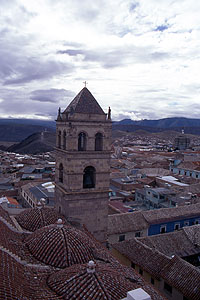
(Potosí, Bolivia)
Having said that the tour was very enjoyable, it maybe just went on a bit too long. This fact was bourne out by our acetylene lamps which began to run out on the way out. In fact by the time we got to the entrance only my lamp was working out of the five of us (guide included). We got changed and after a long wait were taken back to Potosí in the agency's jeep, the other group with the agency having been let out hours before us.
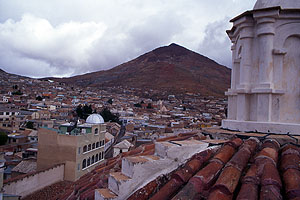
(Potosí, Bolivia)
By the time we had scrubbed up it was almost four. We had hoped to look at a couple of Potosí's many huge churches that afternoon but there was very little time left. We managed to waste most of this time looking for San Bernando before I realised that it was actually San Francisco that we were interested in. When we finally got there we had to pay five dollars to get in and had less than fifteen minutes. I rushed up to the roof to get an amazing panoramic view over the city and take a few photographs. After this we were quickly shown the crypts and were given the briefest of run downs on the paintings in the church and around the courtyard of the attached monastery. After leaving the church we poked around the streets of Potosí a bit more and then went for dinner with Hans and Ester.
Friday, 12 March 1999
Sucre, Bolivia
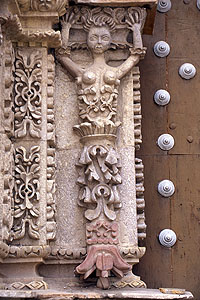
(Potosí, Bolivia)
We had arranged to go around Potosí's Casa Moneda, the former royal mint and supposedly the best museum in Bolivia. Access was by tour only and we were told that our guide only spoke Spanish. Waiting in the huge courtyard at nine we found that ten out of the twelve in the group were English speaking westerners. Naturally we started tutting about how stupid it was of the museum not to hire a bilingual guide. The guide, who was all this time standing beside us, paid no attention presumably because he could not understand us. Eventually he lead us to the first exhibit and asked us if we all understood Spanish. A rather cross Anna replied "yes, if you speak a bit more slowly", to which he replied, "well I speak English if that would be any easier" in perfect English. We were all a bit taken a back but he went on to explain that they did not like to do the tours in both languages because he took longer. I guess however that he went with the majority because after that we had commentary in English followed by noticeably less commentary in Spanish. The numbers of course evened out as the tour went on as more Latin American tourists turned up as it went on having clearly thought that nine meant "ten at the earliest".
The museum was as it turned out excellent. Potosí's mass of silver meant that it was an ideal place to mint coins for the Spanish colonies and so it became one of the three "Casa Moneda"s in South America. We were shown the process of making money from its very primitive hammer and stamp beginnings right until 1953 when it stopped producing coins and Bolivia began exporting them from Germany. The great thing was that everything that we were shown was at one time in use in the huge building itself. They had a room packed full of the die's that were used to make money and medals right through Bolivia's history. They also had a room containing three huge silver rolling machines made of oak and powered by mules in the room below. Towards the end of the tour things started to get a bit erratic because it was clear that the museum had more stuff than our guide had time. In fact we had to leave before it was finished and so missed some of the more recent minting machinery.
We spent most of the afternoon on the bus to Sucre. It was a pretty uneventful ride but as we drew into the outskirts of what confusingly is Bolivia's second capital we realised that it was a very beautiful city. A large amount of the colonial buildings have been preserved and are kept immaculately whitewashed by law. Many of the houses retain their gigantic wood and iron doors and a few have intricate wooden balconies. We found a hotel quite quickly and were able to stroll around a bit in the setting sun. The city also has quite a lively cafe scene and it was in one of these cafes that we met later and had one of the most convincing pastas we had eaten for a long time.
Saturday, 13 March 1999
Tarabuco, Sucre, Bolivia
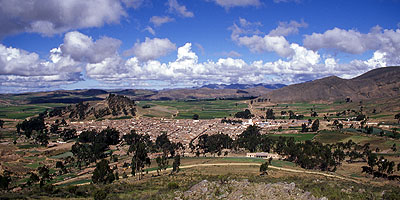
(Tarabuco, Sucre, Bolivia)
As much as we liked Sucre we were not staying for long. By a stroke of good fortune the second weekend in March happens to be when the people of Tarabuco celebrate Phujllay. To explain a bit further Tarabuco is very close to Sucre and Phujllay is the celebration of the battle for the town's independence in 1816 and is one of the liveliest celebrations in Bolivia.
So we hopped on a bus and got there around lunchtime. We found the place in the midst of a town wide hangover. We went into the only listed hostel and a totally incomprehensible guy told us there was no room. We then asked in a cafe and here they just made fun of us. I waited in the central square while Anna asked both in the church and the police station but it was looking like we would have to go back to Sucre. We had the tent but every inch of flat ground, of which there was not much, was covered in fields. Fortunately at this low we ran into Hans and Ester. They had been talking to someone about accommodation in the central square when a woman came along and offered them her floor. We told them of our problems and they offered to decipher what people were trying to say. We went back to the hostel and found out that the person who told us that there was no room had nothing to do with the hostel. Although the owner was also very drunk we managed to get some sense out of him and after some toing and froing we arranged to camp in the courtyard of the hostel for next to nothing.
The festival itself was showing little sign of getting going. Half-cut campesinos wandered around the streets and we had lunch in the market with a few of them and exchanged pleasantries. We gradually got the picture that most of the action would be in the evening, the day effectively reserved for recharging batteries and, for the more resilient, private parties. So we wandered around poking our noses into the few shops that were open and generally killing time. Hans and I went for a walk up to the top of one of the nearby hills and got an overall view of Tarabuco (which was quite big) and then walked back. As the afternoon wore on the atmosphere began to get more and more charged and everyone slowly slipped into the party spirit. We had dinner at a very clean stand in the square where a woman prepared burger and chip butties for 20p. Our choice of stand was approved by Hans and Ester's hostess, a quite well healed La Paz woman who had inherited a house in Tarabuco, who told us it was the place to eat in Tarabuco.
The main event of the night was a pena in the school hall which was due to start at seven. We turned up at seven and naturally there was nothing going on. We went back to the main square and found that a parade of sorts had started and some locals in local dress with cymbals attached to the backs of their shoes were dancing around the plaza. We watched this for a while then I think we drifted back towards the school hall where a guy was shouting "hola, hola, hola" into a microphone. We sat down in the hall to chat but soon afterwards we were flushed out and told that we had to go outside the school gates because they needed to charge 5 Bs entry. After this we rotated between the plaza and the gates of the school. The action in the plaza was pretty wild and some very high westerners were even participating in some frenzied Hare Krishna like parade.
To cut a long story short the pena did not start until nine, two hours late. We seized some beer crates and used these as seats and watched the show. The first couple of acts were pretty forgettable. The guys with the cymbals on their shoes turned up and stamped around the stage. To our utter amazement after exiting the stage they went into the playground and continued stamping throughout the night, we concluded that they must have been chewing a lot of coca leaves. Then a real folk band called "Expression" got on stage. They were very good but suffered from a very poor PA system. Curiously the guy responsible for the microphones had positioned himself next to the stage rather than in the body of the hall so had no idea what a balls-up he was making. Anna, who was trying to record the whole thing, appraised him of the situation and a couple of musicians swapped around but it made little difference. Despite this we enjoyed it a lot and everyone clapped along in time.
Before I explain what happened next I have to backtrack a bit to the hostel we were camping in. By putting our tent up we started a bit of a craze and were soon joined by a uniquely dressed Japanese guy with a cheek full of coca leaves and his head in the clouds. He appeared at the start of the peña with a group of Americans and got our full attention by asking the ticket collector if he could have his chair and amazingly getting it. We christened him "Yoko Ono" on account of his looks and got down to chatting about how isolated and eccentric the few Japanese travellers we had met were. Anyway later on Expression announced that they were going to make a presentation of a signed poster (!) and guess who was going to receive it? Yoko Ono. He got up on stage received the poster and then neglected to get off. The band then started up with their next number and our friend decided to dance - in front of the band. The image of a Japanese guy, dressed in what could only be described as pyjamas covered in pastel teddy bears with a beret on his head and long hair, doing what could also only be described as a demented body popping act to a traditional Bolivian folk band was too much for the audience and everyone collapsed in fits of laughter. We were the worst. Despite wishing that there was a bit more dancing (as well as no microphones) our previous knowledge of Yoko Ono meant that we were practically crying with laughter. After one number and several comments from the band he finally found his way off stage.
The next band we never got the name of but the lead zampona player Orlando Poso we had seen before entering the school in front of a horde of seemingly adoring school children. We later on asked them if Orlando was a big Bolivian star and they casually replied No. Despite this I guess he was the biggest thing to come to Tarabuco, either this or the children were being polite. Anyway his folk band was also very good. The star of the show was the rather animated drummer who leapt around the stage holding his drum aloft and getting the crowd to join in. The band was outfitted in saffron shirts and tights and black plus fours and waist coats. Because of this you could not escape the fact that the drummer looked something like a medieval court jester. We watched for a while and at about one Hans and Ester left. This was a shame because they missed two hilarious incidents. Firstly Yoko Ono made a reappearance. This time, uninvited, he just walked up on the stage and started doing his funky thing. We were again in tears. Secondly, again evoking memories of the Beatles, Orlando let the drummer get up and sing a couple of numbers. He was fantastic, he had an awful voice and bounced through his songs in the manner of a drag act jumping into the audience and stroking the hair of men in the front line whilst serenading them. He even serenaded Orlando, who did not seem keen on the damage it was doing to his careful groomed superstar image.
After Orlando a Peruvian band came in. However they just shuffled around the stage playing zamponas badly so we decided to call it a night. Interestingly although the peña stopped quite soon afterwards the party did not. It turned out that people carried on drinking until eight the next morning.
Sunday, 14 March 1999
Sucre, Bolivia
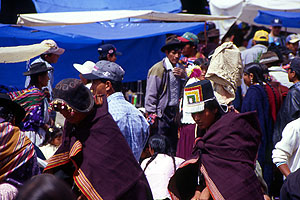
(Tarabuco, Sucre, Bolivia)
We waited as long as we could before getting out of the tent. We stumbled around a bit and finally got out of the hostel. It did not take us long to run into Hans and Ester. They were in the town market trying to take photographs. The market was very much in full swing and people dressed in the regional costumes of the surrounding areas were milling about. The problem was that the regional costumes were pretty outlandish. Headdresses ranged from the bowler hats of the Quechua's, through Conquistador helmet style to French Foreign Legion affairs with pompoms on the top. However from previous experience we knew that if you did the courtesy of asking for a photograph rather than refusing or being proud of the fact you were asking the locals had a tendency of asking for money in return. And not just a few pennies, we had asked a couple of Foreign Legionnaires and they had asked for a dollar a piece a photo. To combat this Hans had hid himself in the shadows of the market clicking away and saving hundreds of dollars.
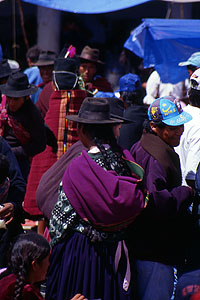
(Tarabuco, Sucre, Bolivia)
I cannot say I entirely disagreed with this approach. Of course there were a few people around who did not want to be photographed but the prevailing atmosphere was mercenary (well we were in a market) and it is always good to cheat the system. After all we were helping them financially in a more positive way by eating in the market etc.
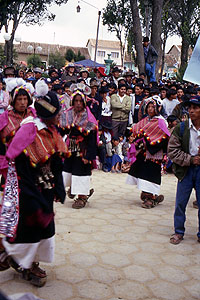
(Tarabuco, Sucre, Bolivia)
After the market we moved into the plaza pending the grand parade. In the plaza we ran into Rebecca (the Australian park ranger) who had come from Sucre for the day like a lot of tourists (including the Prince of Denmark!). Sadly it was not to be. The parade consisted of an endless succession of cymbal-shoe dancers from various local communities. It was great but we had seen it all the night before. Worse than this by the third group it had started to drizzle and ten minutes later it was torrential. The spectators retreated under plastic sheets and the parade tried to brave it but it all fell apart at the seams. We found ourselves trapped in the town hall waiting for the rain to stop and when we realised it was not going to we were forced to run for it. We got soaked but after a quick change of clothes we were able to hop into the bus back to Sucre (which was right outside the hostel) not too worse for wear. We felt a bit sad about the whole thing because the parade was such a big thing for the local communities - however I felt sure that they would more than make up for it during the evening's drinking.
As we had thought the weather back in Sucre was a little more clement and once we had checked back into our hotel and dumped our bags the chaos of Tarabuco was a million miles away. We ate in a Chinese restaurant and ran into Hans and Ester, who had affected a similar escape, whilst we were walking towards the Bibliocafe for after dinner beers. Ironically they had just come from looking for us there. We chilled out, had crepes, read The Economist and drank. A lot later Hans and Ester joined us for a few minutes before the two of us went to the cinema. After "There's Something About Mary" in Santiago, "Armageddon" in Sucre was a disappointment. The sound was bad, the print was bad, we had seen the last half of the movie on the Chaiten-P.Montt ferry (although I had thought it was Deep Impact) and worse than everything the film was bad. A few good jokes did nothing to save us from the cheesy father-daughter-boyfriend triangle someone's got to die ending.
Monday, 15 March 1999
Sucre, Bolivia
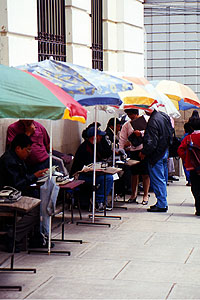
(Outside Central Court, Sucre, Bolivia)
First thing, for us, we went out to the bus station to get our bus tickets for La Paz. Uncannily Hans and Ester were there doing exactly the same thing so we booked ourselves on the same bus at five thirty. We returned to town to make a first attempt on our present shopping. This did not go too well and we managed to loose each other trying to find an artesania which turned out to be a restaurant. We went for lunch and then followed our map to a restaurant which fortunately turned out to be the artesania we had been looking for. Sadly it was closed and after we found this out it started raining. Inevitably we ran into Hans and Ester again and they helped us with our quest to find a CD of Expression - it turned out that it was totally sold out and not even the band had one. We parted company although Ester seemed keen to come with us on our quest for local weavings.
It turned out that the Artesania was not closed for lunch - it was just tat the shop opened on request. Following instructions we went to a house behind the shop and called out for a Senora Maxima. Mrs Maxima turned out to be well into her eighties and we shuffled along behind her towards the shop. It was an Aladdin's cave, every single type of poncho or weaving was there. The shop was piled high from floor to ceiling with stuff that would make an Islington ethnic gift shop owner's eyes pop out on stalks. We were particularly after Jal'qa weavings but sadly I think so had everyone else been because she had only a few bits and bobs. What she did have however were some excellent strips of weaving with crazy animals on it. We rifled through them trying to find the best of the best and all the time the woman muttered telling us how beautiful they were and naming all the animals on them.
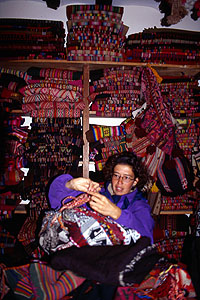
(Sucre, Bolivia)
We were forced to pursue Jal'qa weavings at the local museum shop. This was not as sad as it sounds because a Swiss group ASUR had organised local weavers giving them quality wools and selling their products in a westerner friendly environment. Everything there would have caused the afore mentioned ethnic gift shop owners to cream their jeans. The quality ranged but it was so accordingly did the price and the designs were unique. We deliberated for what seemed like hours and in the end picked one for that was so intricate that I still look at it and see new things. The price was high but low compared to what it was worth and we were assured that sixty percent went back into the community.
After deliberating for so long we practically had to run for the bus. The bus journey itself was bizarre. For one Bolivia is so lacking in roads that to get between the capitals you have to go back to Potosí and even then a fair piece of the trip is on non-surfaced roads. Secondly we had massive problems with the driver, he would not switch the reading lights on and insisted on driving at an incredible speed. We kept on asking about the lights but the steward was incredibly rude and actually attempted to ignore us. Ester asked the driver to slow down which worked for a while but soon he was driving at top speed. The only things that slowed him down were getting a puncture and the fact that the paved road ran out. I slept like a log but I believe everyone else had problems.
Tuesday, 16 March 1999
Sorata, La Paz, Bolivia
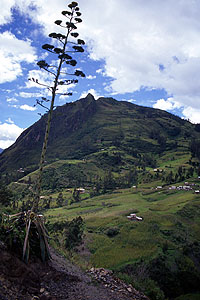
(Sorata, La Paz, Bolivia)
We arrived in La Paz first thing in the morning. It was very misty so when we came through El Alto and found ourselves on the edge of the pit in which La Paz is situated instead of seeing the city laid out in front of us we saw nothing but white. At the bus terminal we waited while Hans and Ester made a complaint about the bus. When we finally got out into the city we were less than impressed. Anyway Anna and I had only come into the centre to get some cash and then get the next bus out. We said goodbye to Hans and Ester and caught a micro to the city cemetery which was where a lot of the semi-local buses leave from.
The journey to Sorata provided a dramatic change of scenery. Around Lake Titicaca the flood plains and hills were very desolate covered in little more than grass. We then climbed up into the clouds and suddenly swung down into a beautifully lush valley. We then hopped over into the valley in which Sorata sits switch backing our way down from a high ridge to the valley floor to cross the river. Because of the steepness of our surroundings it took a long time to get there but five hours after leaving La Paz we finally pulled into Sorata's Plaza del Armas. The town itself is very beautiful, at 2600m and facing the Yungas it gets much better weather than La Paz. The town itself experienced a slight boom due to rubber and quinine plantations in the steamy Yungas below and this has left it with a few large colonial style buildings. The Residencial Sorata, where we stayed, was one such place. Built by German plantation owners it was a sprawling affair with two courtyards, a beautiful garden and rooms of classical proportions that have a sort of elegance even though they have seen better days. After settling in we had a brief tour of the town and then found an Italian restaurant for dinner.
Wednesday, 17 March 1999
Sorata, La Paz, Bolivia
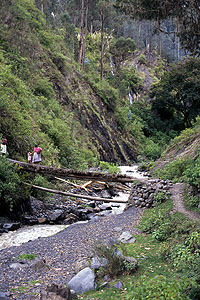
(Sorata, La Paz, Bolivia)
The big and slightly collapsed four poster bed in our room did not prove easy to get out of. By the time we finally escaped it was close to lunch time. We found a very European vegetarian restaurant on the plaza and because the menu was so inviting we decided to abandon our carnivorous instincts. At the time only one of the owners, Roxanna, was there. I think she was Bolivian and since she spoke excellent English we mined her for information about Sorata.
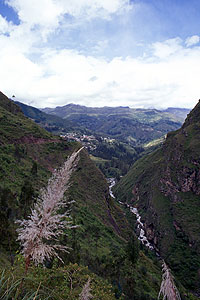
(Sorata, La Paz, Bolivia)
After lunch we decided to walk towards the village of San Pedro, further down the valley. The start of the walk involved following a short cut through town. Pretty soon we were walking along a beautiful hillside track lined with an amazing variety of flowers. After a while this opened out and after looping around a small valley packed with farms we found ourselves in some amazing scenery. The road from Sorata to San Pedro is cut into the sheer sides of the river valley a few hundred metres above the river itself. This offers breathtaking views of the course of the river as it winds its way towards the Yungas. One memorable sight was where the rain had eroded a spur into a collection of pinnacles which towered above a bend in the river. We did not go all the way to San Pedro as we were a little short of time but we got far enough to reach the point where the mountains began to drop away giving us a view out over what looked like the tree canopy of the Yungas and ultimately the Amazon Basin.
On the way back to Sorata we stopped at a place owned by the people who ran the vegetarian restaurant in town. It was staffed by a traveller from New Zealand who had grown to like Sorata and we talked briefly with her whilst enjoying an expensive cup of tea and chocolate brownie. The place was down by the river so it was quite a relief to find out that Johnny, Roxanna's husband, was driving back into town and could give us a lift. Johnny, it turned out, was one of those people who is so terminally laid back that you wonder why the hell you are not running a restaurant in deepest darkest Bolivia. It turned out that despite being born in Bolivia he grew up in Europe and did not return to his home country until a holiday many years later whereupon he decided that it was time to return and open a vegetarian restaurant in Sorata. We chatted to him for the long winding journey back to the Plaza and then returned to our hotel. We rounded the day off with dinner in the hotel followed by watching "Snake Eyes" with Nicholas Cage on video.
Thursday, 18 March 1999
Sorata, La Paz, Bolivia
We had intended to spend the whole day walking in the hills above Sorata but we had a bit of an argument and ended up not getting out of the room until lunch time for the second day in a row. In lieu of the long walk we decided to walk out of town and find somewhere scenic to have our lunch. It was blisteringly hot and like the day before we were continually pestered by small yellow and orange blood sucking flying insects. We found a windy spot on a small spur and had our lunch looking down into the river valley above Sorata. After lunch we continued walking a bit further and rounding one corner were rewarded by a view of the brown snow clad peak of Illampu. It was a bit of a surprise because although we knew that Sorata was at the base of this massive mountain we had never seen it and did not really know where to start looking for it. Sadly it was only a brief sighting as soon afterwards it disappeared into the clouds and became virtually undetectable again.
We returned to Sorata via a different path which emerged quite a long way above the town. This gave us a unique view of the town's rusting corrugated iron roofs and the courtyard structure of many of the buildings. We worked our way down between the vegetable gardens of the townsfolk and eventually got back to our hotel. After lounging around for a bit we went back to the vegetarian restaurant for a beautiful dinner of stuffed pumpkin and then again paid a visit to the hotel's video room where they were showing "The Rock" again starring Mr Cage along with Sean Connery who as usual did not disappoint on the one-liners front.
Friday, 19 March 1999
La Paz, Bolivia
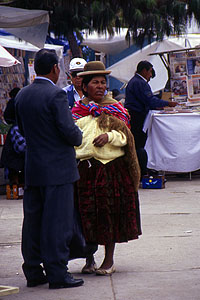
(La Paz, Bolivia)
We were a bit sad to be leaving Sorata and especially sad to be leaving at five in the morning. We calculated that by leaving so early we could get to La Paz early enough to get all the things we needed to do there done and get away first thing the next morning. What made matters worse however was that it rained all of that night and at four in the morning the rain still had not stopped. Nevertheless we tumbled out of bed and into the bus. I slept for most of the start of the journey but even after I woke up there was still no change in the weather and no real view to speak of.
In La Paz we soon found a nice-ish hotel and then we hit the streets. It must be said that our first impressions of La Paz were a little misleading. After a while of poking around the back streets and the quite pleasant area around the Plaza Estudiante we began to realise that amongst the drabness La Paz did have a bit of character. Of special interest was the "witches market" where they sold lucky dead llama foetuses and herbs for every ailment. The market negro was also quite a laugh basically being a never ending sucession of stall selling (very bad) fake designer jeans.
The main object of our shopping trip was to get hold of a zampona for Anna. This presented a problem in that although I could just about manage to get a sound out of a fair percentage of the thousands of instruments lining the streets of La Paz Anna had difficulties. This made it hard to judge which instruments were in tune. Worse than this we found a music school run by a very famous zampona player and maker and he had excellent instruments but of course charged quite a bit for them. Since Anna wanted them for school we decided not to go for the professional model and settled on something cheaper but vaguely in tune. It all took hours and was all very confusing because the sound that the instruments produced varied a lot with the skill of the person demonstrating it. One thing that must be said is that I never wanted to hear "El Condor Passa" (aka the one that Simon and Garfunkel used) ever again. It is clearly to zampona's what "Stairway to Heaven" is to electric guitars.
By the time most of the shopping was complete it was time to go to dinner. We made a very grave error in our choice of restaurant by going to one that supposedly had a peña. The meal was expensive and not very good and just as we finished the first group came on. They appeared to be a bunch of spotty university students dressed in ponchos and the politest way of describing their music would be to say it was "experimental". After this we were treated to some traditional dancing from Potosí, which was little more than some people in traditional dress hopping around to a rather badly recorded tune. It was all too much for us and we decided to pay and go. However when we finally got the bill there was an extra six dollars added to it, roughly another thirty percent. We asked what it was about and they told us "for the music". At this we were amazed, we had thought that the price of the food would more than cover the entertainment and besides we were leaving before it had a chance to get going. We pointed out to the waiter that nowhere in the restaurant or in the menu was a charge for the music mentioned. His reply was "it is written in all the guide books". This frankly was too much for us and since we did not have a guide book on us we attempted to point out that this was not a sufficient excuse and what he was doing was pretty close to robbery. In the end we gave him exact money for the food and then stormed out. I think the main reason they let us go was that they did not want anyone else to find out why exactly we were so cross. It did not finish there, a waiter followed us half way back home and accosted us trying to claim that we had not paid enough for the food. He then proceeded to severely embarrassed himself by adding the bill up in front of us and finding out that we were right all along. We were a bit shaken by the whole thing and considered making a complaint to the tourist police. After all we knew that there was a peña in the restaurant but it would have been very easy for any luckless traveller to wander into the restaurant without knowing this and have an extra thirty percent slapped onto their bill.
Saturday, 20 March 1999
Copacabana, La Paz, Bolivia
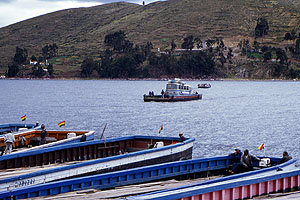
(Copacabana, La Paz, Bolivia)
"The best laid plans of mice and men..." - of course we did not leave on the first bus and spent all of the morning doing more shopping. The thing that consumed a lot of time was a last minute dash to find some of those typical Bolivian scarves which are very long, very thin and are made up of tons of bands of different coloured wool. The interesting thing was that in the few places we found them they either had very tacky synthetic new ones or nice but rather threadbare and dirty old ones. In the end we found a woman who had hundreds of them and we annoyed her by going through them all in an attempt to find some that were presentable.
The bus to Copacabana on the shores of Lake Titicaca was to say the least eventful. We managed to get to the Straits of Tiquina, where the bus is supposed to cross the lake at its narrowest point, without any problems. However when we arrived our bus driver said it would be another hour before we crossed. We started to wait but soon it became clear that all was not quite as he said. We asked around and assembled bits of the puzzle. It appeared that the inhabitants on the other side of the Straits had set up a road block and were not letting buses through. This much turned out to be true but quite why they were doing it differed according to who you asked. It seemed to have something to do with the big bus companies and money and the inhabitants not getting a bigger share of it. It seemed a bit like blackmail but we did not have all the facts so could not condemn it.
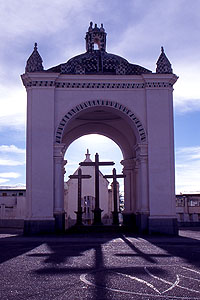
(Copacabana, La Paz, Bolivia)
Whatever the reason we had a problem. We returned to the driver with the facts and he admitted that the bus would not be leaving until "mas tardes". We unloaded the backpacks and set off towards the passenger ferry in the hope we would find some vehicle to take us the final thirty kilometres. Even the ferry was eventful. The pilot of the boat had for some reason left his bicycle on the roof of the small boat without tying it down. Of course we hit some choppy water, the boat rolled to one side and the bicycle fell off. The pilot looked like he was going to jump but someone stopped him and we all watched as the bike sank into the deep blue waters of the lake. On the other side there were lots of people hanging around and no obvious form of transport. Fortunately Anna spotted a minibus packed with locals and after a while of them ignoring us they finally agreed to squeeze us in. We approached the first road block tentatively and someone, who acted as a "fixer" throughout, got out and talked to the protesters. Eventually we edged our way through the crowds. We thought we had made it when suddenly a villager kicked the side of the minibus. Nevertheless we managed to get through the crowd and sped off. After this we experienced a never ending series of manned and unmanned roadblocks. The minibus had to weave through huge boulders pushed onto the road and our fixer had to get out numerous times. At one point someone even threw a rock at the minibus. It took us a long time but finally we emerged over the top of a low pass and were able to see Copacabana below us.
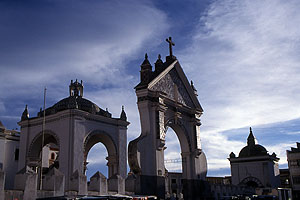
(Copacabana, La Paz, Bolivia)
Copacabana is a mixed sort of place. On the one hand you still have the muddy dirt tracks instead of paved streets in all but the central square. On the other hand the church is something out of this world. It is of a grandiose Moorish design and is decorated with coloured tiles - something we had first seen in the mosques of Pakistan. Anna briefly looked in that night but we had to find hotels, dinner etc. so exploring had to wait for another day.
Sunday, 21 March 1999
Copacabana, La Paz, Bolivia
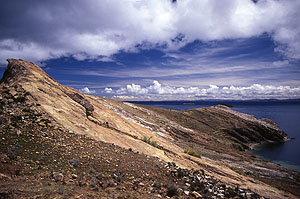
(Copacabana, La Paz, Bolivia)
We could have stayed for a few days in Copacabana but we were determined to press on to Peru and had allotted ourselves only a day. We decided that the thing to do was to catch a boat to the Isla del Sol - In Inca mythology the birth place of the sun - and rather than pay much attention to the ruins there walk from one end to the other. We went down to the docks as first thing in the morning as we could manage and found the next boat leaving for the Island. The trip was scenic if not a bit slow, cruising on the still, dark blue waters of Lake Titicaca. We cruised up the coast of the peninsula which Copacabana is located on then dramatically squeezed through two smaller rocks and found ourselves alongside the island.
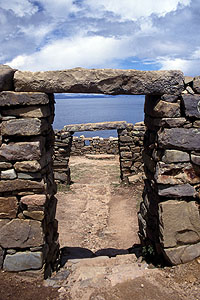
(Isla del Sol, La Paz, Bolivia)
After about two hours we came to a stop at the docks on the north end of the Isla del Sol. It was about half past ten and we had until four to get to the south end. People have inhabited the island since Inca times and getting off the boat we found ourselves in a small village. Most of the younger inhabitants of the island were playing football around the back of the museum including the guy selling tickets. Sadly he noticed our arrival and broke off from the match to collect the money. The walk to the ruined palace close to the very tip of the island was very interesting. It became clear very soon that despite being quite barren looking the island was in fact covered in springs. Streams crisscrossed the path and there was the occasional patch of lush vegetation. As we suspected the ruins of the Placio del Inca were not much when we finally arrived. As for Titikala, the Rock of the Puma, itself I must admit that we either failed to find it or, more probably, failed to look at it from the right direction.
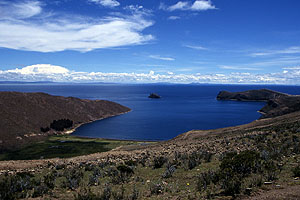
(Copacabana, La Paz, Bolivia)
The walk along the spine of the island on the other had was magnificent. We ascended quickly and soon were able to see down to both sides of the island, the town on one and a deserted, tree fringed, deep blue bay on the other. We were also able to see a lot more of Titicaca itself and the few islands dotted around. In a few places we were crossing barren rock but there were still a lot of springs which supported patches of boggy grass. Before long we reached the highest point on the island and swung around to find ourselves above a virtual amphitheatre of cultivated terraces. Here we were pretty much at the end of what turned out to be our two and a bit hour walk. We went through a small town, then down a steep slope and onto an Inca staircase leading down to the dock. The staircase however was more than just a staircase. At the top a spring had been channeled to come out of a carved block in three jets and the water flowed down an aqueduct at the side of the stairs. Either side of the stairs the hill was terraced and there a garden grew, irrigated by the waters of the aqueduct. It was a very attractive spot which was just as well because there were no boats to be seen and it looked like we would have to wait.
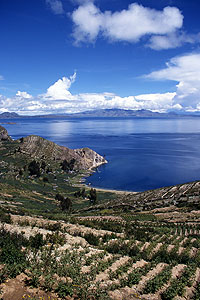
(Copacabana, La Paz, Bolivia)
A boat did eventually turn up but sadly, since it was only three, it turned out to be the four o'clock boat we had intended to catch. We sunbathed on its top deck for the hour and eventually it left. The trip back was painfully slow but we passed the time chatting to a few people including a couple of older ladies from California, a Swiss guy, an American couple and an Australian.
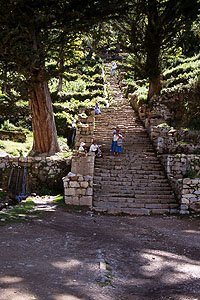
(Isla del Sol, La Paz, Bolivia)
We got back to Copacabana just at the right time. We dashed through town and got to the Cathedral just as the sun was starting to set thus allowing me get some, hopefully, nice pictures of it. Later on we had dinner at a great place we had in fact found the night before. All the plates etc. were made out of unglazed ceramics and the place had a very warm feel to it. The food was traditional Bolivian and the night before I had a Pique a lo Macho which was about six thousand times better than the one I had braved in Potosí. This night we had trout, a Titicaca speciality, which was great but the traditional Andean accompaniment of quinoa, slices of sweet potato, beans etc. needed a bit of spicing up.




